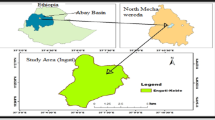Abstract
Egypt faces great challenges due to its limited water resources by enforcement policies to improve the performance of the existing delivery system and its development. The improvement of irrigation systems in the Nile Delta is one of the most important attempts in Egypt to implement more effective irrigation technologies. This study was carried out to evaluate improved tertiary canal level and farmers’ practices by comparing with other unimproved systems to understand the farmers’ practices in their farms after modifying the existing irrigation system. This study area applied to the Wasat command area’s most commonly used to the cultivation of a paddy field in Egypt, which contributes 40 % of production. The overall results indicate that the water-use application at the improved system level improved. This was due to the role of water user association in the successful management and operation of the water-supply system on the private level of water distribution network. So, water users’ association has the positive effect on managing of the improved tertiary canal. Although, there are main problems of water delivery in the irrigation networks that was a water shortage in the main canal owing to its location at the tail of the feeder canal system in the Nile Delta, and other reasons include the absence of crop production planning by farmers, especially rice farmers in summer, and the greater demand of some fields than supply.






Similar content being viewed by others
References
Arafat S, Afify A, Aboelghar M, Belal A (2010) Rice crop monitoring in Egyptian Nile Delta using EgyptSAT-1 data. In: Joint USA–Egypt workshop for space technology & geo-information for sustainable development, NARSS, Cairo
EHWR: Egyptian Handbook for Water Resources (2003) Management of irrigation and drainage networks. National Water Research Center, Cairo (in Arabic)
El-Kashef AM (1995) Meska planning and design manual. Ministry of Water Resources, Cairo (in Arabic)
El-Quosy DE (1997) Change from fixed rotation to continuous flow. Modernization of irrigation schemes. In: Proceedings of expert consultation, Bangkok, 26–29 Nov 1997
EWUAP (Efficient Water Use of Agricultural Productivity Project) (2008) Best practices for water harvesting and irrigation, Egypt. National Water Research Center, Cairo
Hassabou AH, El-Gafy IK (2007) Assessment indicators for water users’ associations in Egypt. E-WAter, Official publication of the European water association (EWA) 2007/2:1–14
Hvidt M (1996) Improving irrigation system performance in Egypt: first experience with WUA approach. Int J Water Resour Dev 12(3):133–140
Molden DJ, Gates TK (1990) Performance measures for evaluation of irrigation water delivery systems. J Irrig Drain Eng 116(6):804–823
MSEA (Ministry of State for Environment Affairs) (2008) Environmental characterization of Kafr El-Sheikh city. Environment Affairs Sector, Kafr El-Sheikh (in Arabic)
MWRI (Ministry of Water Resources and Irrigation) (2005) Water for the future: national water resources plan 2017. Planning Sector, Cairo
Savva AP, Frenken K (2002) FAO (irrigation manual): module 4 crop water requirements and irrigation scheduling. Sub-Regional Office for East and Southern Africa, Harare
Smith M (1992) CROPWAT: a computer program for irrigation planning and management. In: FAO irrigation and drainage paper 46, Rome. ISSN 0254-5284
SWERI (Soil, Water, and Environment Research Institute) (2001) Assessing the impact of climate on crop water need in Egypt: the CROPWAT analysis of three districts in Egypt. Agricultural Research Center, Cairo
WAGS (Water Awareness and Guidance Sector) (2008) Rice problem in Egypt. Ministry of Water Resources and Irrigation, Cairo (in Arabic)
Acknowledgments
The author wishes to thank Global Center of Excellence for Dry-land Science (Global COE program) funded by the Japanese Ministry of Education, Culture, Sports, Science, and Technology in Arid Land Research Center of Tottori University for the funding on this research. This work was supported by Water Management Research Institute (WMRI) of National Water Research Center (NWRC) in Egypt.
Author information
Authors and Affiliations
Corresponding author
Rights and permissions
About this article
Cite this article
Mohsen Aly, A., Kitamura, Y. & Shimizu, K. Assessment of irrigation practices at the tertiary canal level in an improved system—a case study of Wasat area, the Nile Delta. Paddy Water Environ 11, 445–454 (2013). https://doi.org/10.1007/s10333-012-0335-1
Received:
Revised:
Accepted:
Published:
Issue Date:
DOI: https://doi.org/10.1007/s10333-012-0335-1




